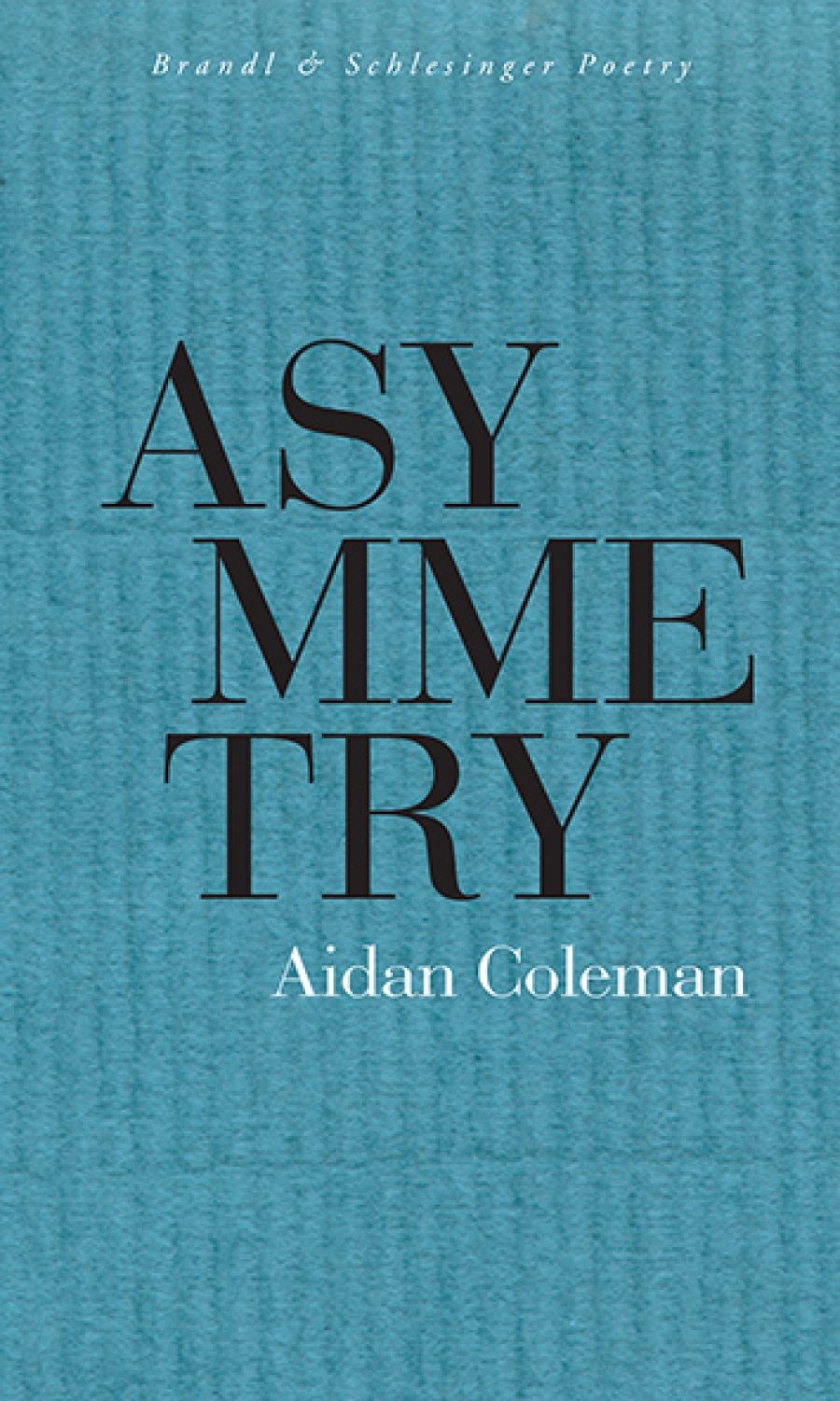
- Free Article: No
- Contents Category: Poetry
- Review Article: Yes
- Online Only: No
- Custom Highlight Text:
In July 2007, at the age of thirty-one, Aidan Coleman suffered a stroke as a result of a brain tumour. Asymmetry is a book in two parts. The first details the poet’s survival after this near-death experience, his struggle to regain full use of his body and to speak and write again. The second part is a group of love poems for his wife, Leana ...
- Book 1 Title: Asymmetry
- Book 1 Biblio: Brandl & Schlesinger, $24.95 pb, 71 pp, 9781921556319
Aidan Coleman’s first book, Avenues and Runways (2005), introduced us to a young but highly accomplished imagist. Some of that imagism can be traced back to the early influence of Robert Gray, but there is also a concision in Coleman’s work that pushes him further towards minimalism than is the case with Gray. Coleman is part of a group of South Australian poets who have absorbed techniquesfrom European minimalists such as Vasko Popa and Miroslav Holub – a group that includes Peter Goldsworthy and Steve Evans.
Coleman is also part of a long tradition of Australian poets who write about the suburbs. While aware of suburban conformity and shallowness, he finds space within suburban settings to celebrate their freedoms. Perhaps Coleman’s job teaching English and History in the northern suburbs of Adelaide imbued his poetry with some of that wide openness of the plains, an almost mystical sense of possibility, particularly when he looked across the outskirts at night to the distant lights of the city. Those early poems of his sparkled with short-line clusters.
So how has Coleman’s poetic ability survived the stroke? Orpheus is back from the underworld, and he is writing as well as ever. ( I don’t choose that metaphor lightly.) This book does descend into what it is like to face death, and, in a sense, to come back from the dead. The difference is that Coleman’s Eurydice (Leana) wasn’t the one being rescued; she was there beside him the whole time, leading the rescue team.
Asymmetry takes us to a plane of experience far deeper than that from which most poets can report: death of the body, death of language. At times it is frightening in its spare, super-charged lines:
I died last night, while panic
happened round me;
came awake to a different room.My arm, my legs, perhaps
my mind:I gave them up without a struggle.
It was more gentle than any theft.
Too gentle to believe.
(‘Theft’)
Poems such as ‘The Question’, ‘What Happened’, ‘Shower’, ‘English Kings’, ‘The Advertiser’, ‘PEG Feed’, chart the journey down, then up again, to the recovery phase and painful joy: ‘I wake to legs, / to a message getting through ... / If each kneecap were a mouth, it would be singing’ (‘Path’).
One of the drawbacks of minimalism is that it tends to subordinate the sonic qualities of poetry. In the early 1990s, during his visit to Australia, I asked Miroslav Holub what his poems sounded like in the original Czech, since they didn’t seem to have much music in English translation. He replied that they didn’t have much music in Czech either, and he wasn’t very interested in musicality; what interested him was the play of images and ideas down the page. Coleman’s minimalism differs from Holub’s in this respect. While some of the poems in Asymmetry are sonically plain, others are quite rich. In ‘First Step’, for example, he uses both metre and assonance: ‘in and out of daze // mute, baffled // sleep-depraved. // The ghosts of nurses / check and go // their names / as bland as hurricanes.’
The title of the collectionrefers to the asymmetrical effect of the stroke on Coleman’s body, but also to the fact that the book is made up of two unequal parts. But there is symmetry in this asymmetry. True, the first part about the stroke and the slow recovery of limbs, tongue, and persona is longer than the group of love poems for Leana; but it is this love, present in the hospital rooms and corridors and therapy sessions, that drives the recovery. Death and Love compose the symmetry here; they are the classical facing mirrors of poetry.
In the group of love poems, Coleman shows us his open, respectful, unashamedly male erotic gaze. How refreshing that is, when the male gaze has suffered so much bad press. I particularly enjoyed the sequence ‘Epithalamium’ – an ancient form, a wedding song, originally to send the bride to her nuptial chamber: ‘and once you whispered / ‘husband’ // as if to name / some dark, illicit pleasure.’
Publishing love poetry written for your wife can be hazardous: it is so easy to fall into sentimentality, write coyly to avoid embarrassment, fail to edit with a ruthless eye. With precision, frankness, and inventive imagery, Coleman avoids these hazards. This section of love poems is a joyful conclusion to a fine book:
Dusk brings mauve
and the cool smoke
of sprinklers.Every phonebox seems
a lantern
seems
an open invitation.I go home
and listen to
songs about you.
(‘Falling’)
CONTENTS: SEPTEMBER 2012


Comments powered by CComment